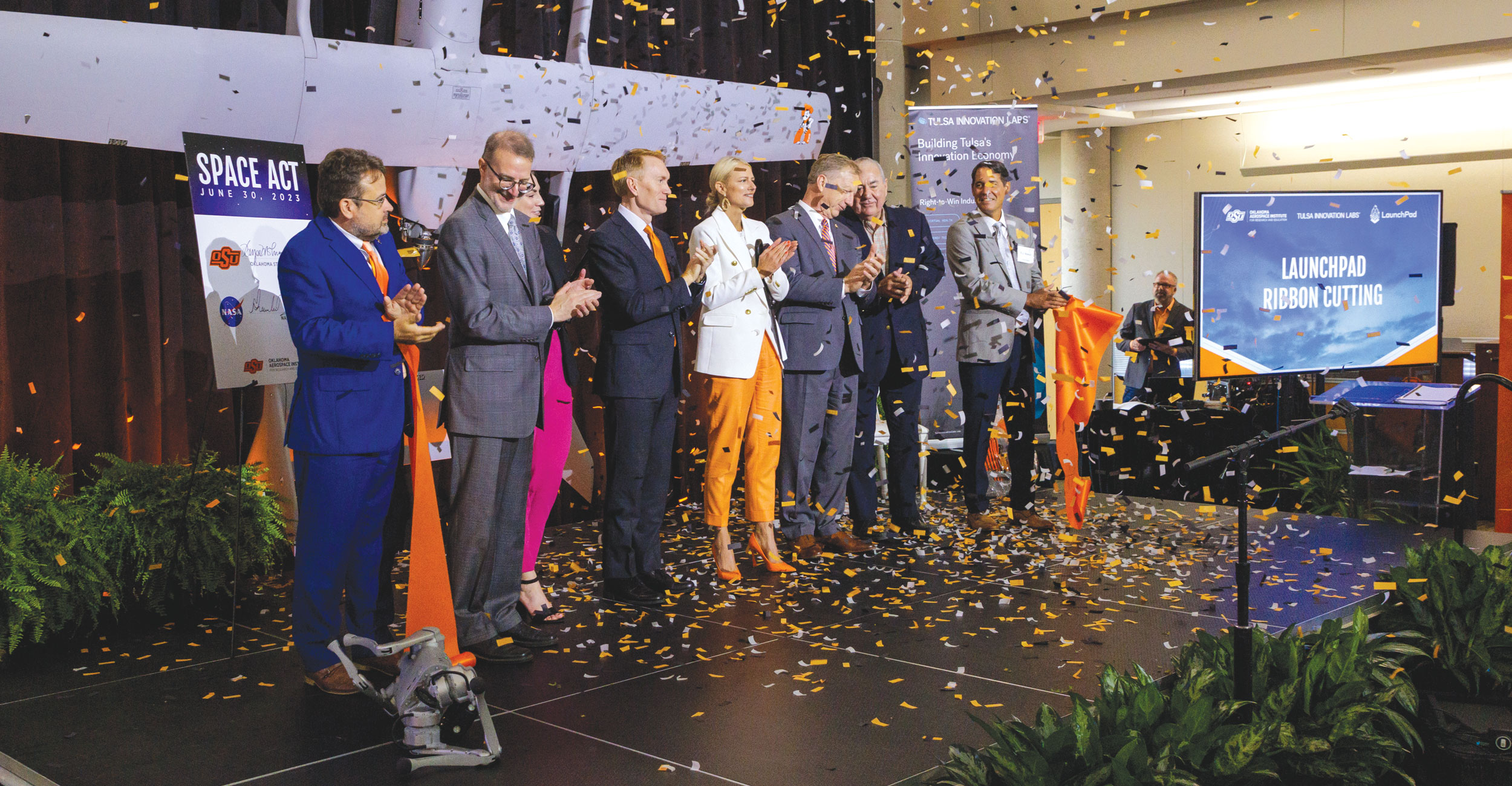
Foundation for innovation: How OSU's applied research institutes are advancing the land-grant mission
Thursday, December 21, 2023
Media Contact: Mack Burke | Associate Director of Media Relations | 405-744-5540 | editor@okstate.edu
“Many ideas grow better when transplanted into another mind than the one where they sprang up.”
Oklahoma State University researchers have long worked together, crossing disciplines and sharing ideas, but they now have powerful new avenues to collaborate and achieve greatness together. During President Kayse Shrum’s tenure at OSU, the university has launched three new transdisciplinary institutes specializing in key areas of its We Are Land-Grant strategy: aerospace, health and energy.
Operating under the umbrella of The Innovation Foundation at OSU, the Oklahoma Aerospace Institute for Research and Education, the Human Performance and Nutrition Research Institute, and The Hamm Institute for American Energy at OSU are uniting researchers and resources from across the Stillwater campus and the OSU System to address some of society’s most pressing challenges. The Innovation Foundation at OSU oversees and is home to this dynamic trio of transdisciplinary institutes and is leading a bold vision to expand applied research and technology commercialization with a focus on maximizing new discoveries and partnerships.
STATE magazine recently sat down with institute leaders to discuss their progress, vision for the future and how their work is advancing OSU’s land-grant mission to serve the state, the nation and the world.
Human Performance and Nutrition Research Institute
High-Performance in Focus
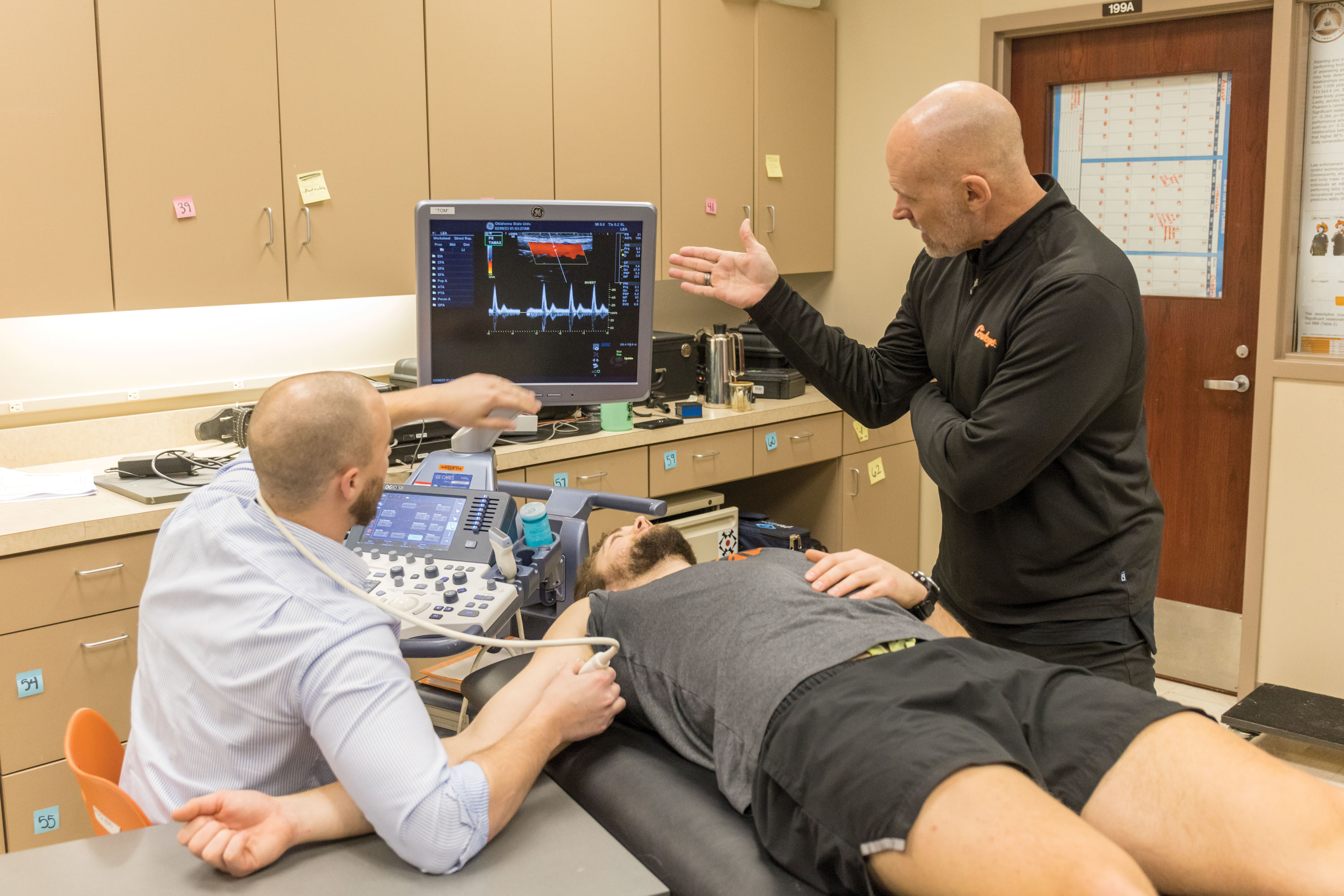
Q&A with Lance Walker, Rick and Gail Muncrief Executive Director
HPNRI launched in December 2022 with the goal of developing preventative therapeutic strategies to combat obesity and chronic diseases and take a performance-focused mindset to Oklahoma’s health challenges. Nearly a year later, and now under the umbrella of The Innovation Foundation at OSU, how would you assess the institute’s progress?
I think we’re taking a big vision to addressing Oklahoma’s challenges, and the grandest challenges as I see it are our health challenges. When we stepped into this a year ago we were focused on one question: How do we leverage a new way of attacking this or a different way of attacking this?
Looking at disease, we wanted to look at prevention through the performance lens. That resonates with people. It’s something that’s an “aha moment” for some folks as well. When we’re talking about performance, it’s not a dichotomous equation where you’re either sick or you’re healthy. We’re all on a continuum.
Over the last year, that conversation has been had one-on-one, in small groups and big groups, and it’s been really nice to see the “aha moments” happen.
Over the last year, I think a big part of my role has been to hear conversation, to spread conversation and to evangelize that concept. And it’s not a hard sell at all. Everybody sees it, they get it, they want to jump in and lock arms to do it. And now it’s about taking that vision and moving it from mission into action.
As the saying goes, an ounce of prevention is worth a pound of cure. But when we’re talking about HPNRI, perhaps it should be that an ounce of perspiration is worth a pound of cure?
I like that! I think that spirit has resonated with folks. When we talk about performance, we’re linking our activities, our nutrition, our lifestyle to something that is important to an individual or to a group. We know what we eat and put into our bodies does impact our health. But let’s think about it differently. Let’s think about how it impacts our ability to meet our life goals.
The high-performance soccer athlete is focused on preparing for game day — performance, not health. But improved health is a natural byproduct of that effort.
The link is obvious when you’re talking about a high-performance athlete, but it applies to all of us. That performance lens changes the conversation and the framework of how we communicate. … When you say “human performance,” people take that in different ways.
For many people, that will bring to mind athletes like Barry Sanders, Cade Cunningham, or Rickie Fowler. But when we talk about performance, it can be about succeeding in the classroom, or a gamer looking to beat the competition, or that CEO presentation before the board. That’s all still performance, right? There’s a physical element to performance, a mental side, a life component and a social-emotional component to that. And right in the middle of a high-performance model is the spirit that drives you. It’s the “why” behind what you do. So when you look at that holistically, through that performance lens, it’s for everyone. It’s literally the full spectrum from cradle to grave and from optimum physical human performance at the highest levels to those that are trying to recover from a surgery or from a physical setback. When you talk about performance, you’re talking about everybody. And that’s every Oklahoman, whether they’re preparing for sport or for life.
What are some key advancements that HPNRI has championed over the last year, and what are you most excited about for the future?
Over the first year, I think it’s been very helpful to understand and take inventory of all the great expertise and work happening here at OSU, where there’s some connectivity between departments and colleges, where there’s opportunity to create some of that connectivity and where we can begin to bring together the basic and applied sciences as well.
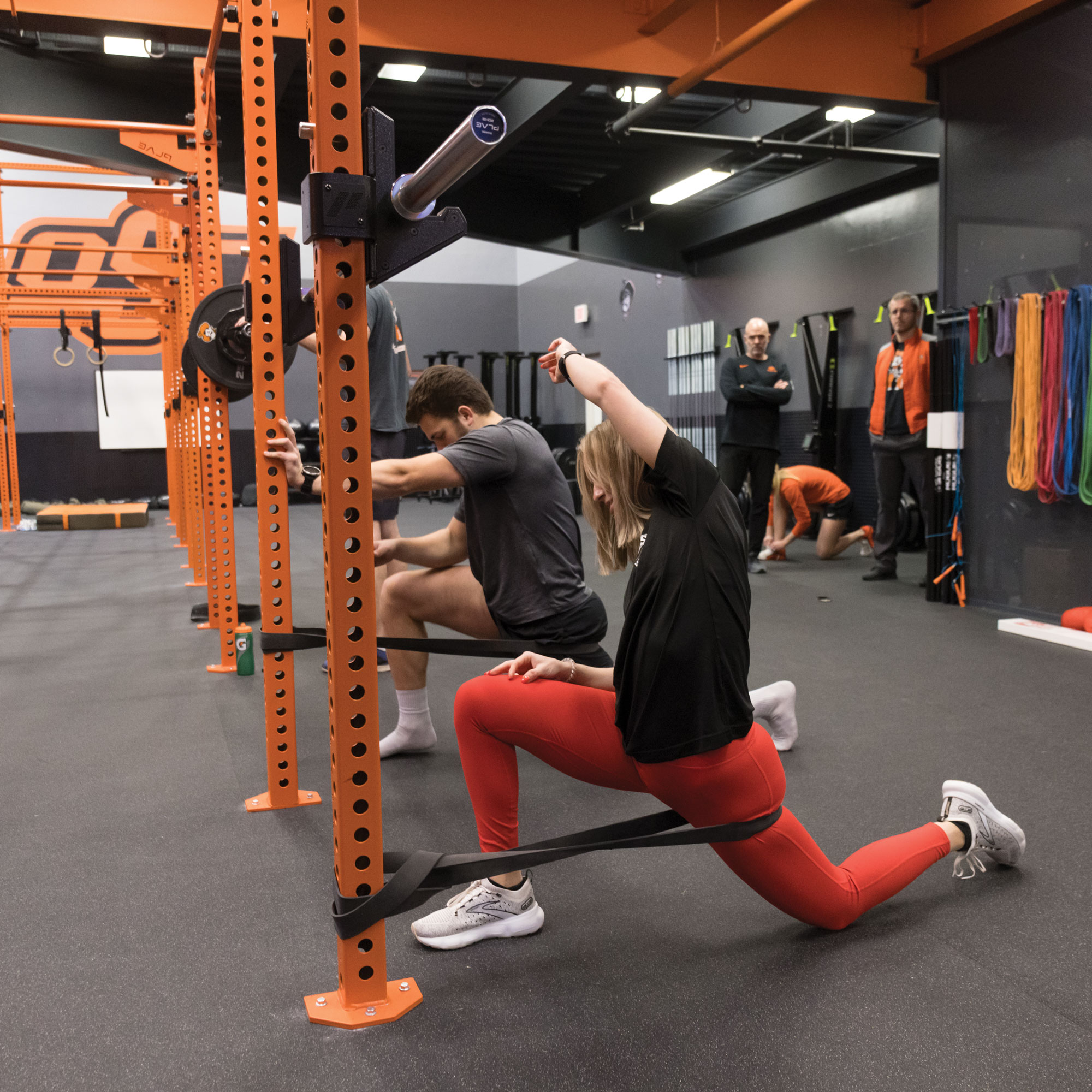
We were able to bring everybody together at the HPNRI Symposium in the spring of 2023, and we’re looking forward to the 2024 symposium and continuing to build bridges between silos and making connections so we can advance innovative solutions together. The energy in the room that day was electric, and we want to keep that momentum. When the new facility is finished, we want that place to be buzzing with transdisciplinary problem solving, a sort of idea collider that inspires new ideas and connections and cross pollinates across the OSU System.
We’re also exploring mega trends and areas of interest for business and industry. We’ve identified some key areas of opportunity for us, areas where our research can have a big impact, and working with The Innovation Foundation at OSU will allow us to pursue those opportunities and build partnerships quickly.
Finally, we didn’t want to wait until we had everything working on the research side to begin Extension and outreach. So I think the biggest tangible win that we can see in this first year has been the launch of a new Project ECHO line on athletic training-sports medicine, the expansion of the existing pediatric obesity line and plans for a new ECHO line in 2024 on building healthy school communities.
Oklahoma Aerospace Institute for Research and Education
Leading from Above
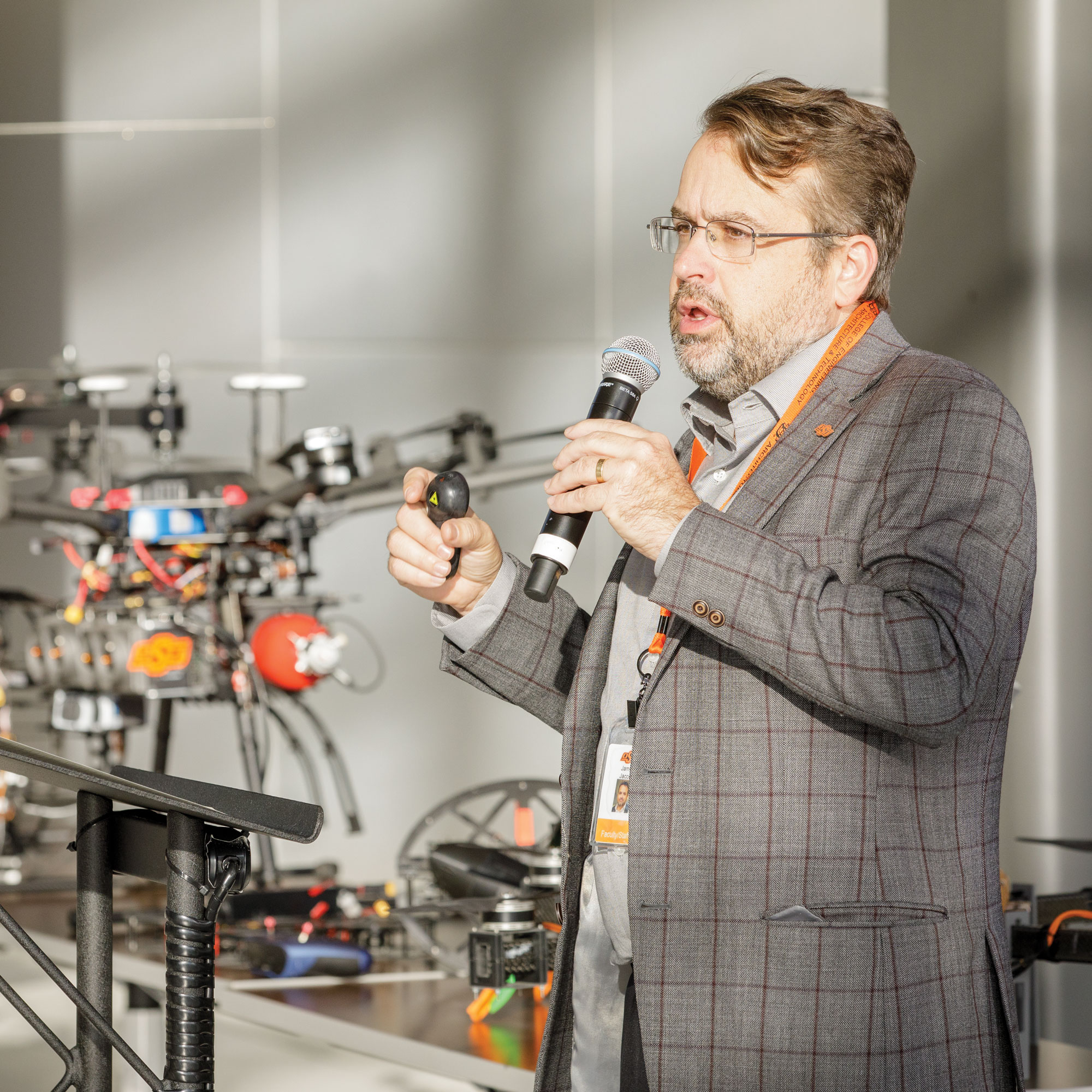
Q&A with Executive Director Jamey Jacob
OAIRE launched in the fall of 2021 with the goal of bringing the state’s aerospace and innovation economy together to drive collaboration and innovation in Oklahoma. Now under the umbrella of The Innovation Foundation at OSU, how would you assess the institute’s momentum?
Growth has been tremendous, and we are accelerating at an exponential pace, both in terms of the projects and the organization of the institute, as we stand up the structure and acquire new capabilities and new team members to help support that.
I’m very pleased with the progress we’ve made. If you look at just the growth in terms of the number of projects, the number of staff members we have on board right now, which includes both research staff and support staff, it is much larger than we anticipated, including research faculty, as well. And our physical reach is now tremendous. That includes our hub here in Stillwater, of course, but we’re also in Oklahoma City, Tulsa and Lawton.
That helps support our land-grant mission and support the entire aerospace ecosystem across the state. That includes supporting research and development for businesses and government agencies as well as workforce development, education and outreach, all of which will be accelerated and enhanced by The Innovation Foundation at OSU.
What is one key advancement that you would point to as a significant victory for OAIRE so far?
I would point to the LaunchPad Center for Advanced Air Mobility, which is being stood up on the OSU-Tulsa campus and supported by an $18 million grant from the U.S. Economic Development Administration and a similar scale of funding from the George Kaiser Family Foundation with our partners at Tulsa Innovation Labs. I think that is certainly our biggest win to date because it demonstrates not only the immense support we’re seeing for this type of effort, both at the federal and regional level, it signals the future of not just OAIRE but of the entire aerospace landscape.
OAIRE has attracted plenty of headlines for its work in unmanned aerial systems, which includes what are commonly called drones, but OAIRE is so much more than that. What does OAIRE encompass and why is it important for it to unite such a wide variety of disciplines and efforts?
OSU has a very rich aviation and aerospace tradition spread across a number of different fields, everything from pilot training, to aerospace outreach and education for NASA, to what we’d call traditional aerospace engineering. The goal is to be able to leverage these unique strengths to create and foster technological innovation across the entire aerospace ecosystem.
As an industry, why is aerospace crucial to the Oklahoma economy?
The aerospace industry in Oklahoma is the second largest industry, behind energy. The third is agriculture. But what makes aerospace unique, particularly emerging aerospace applications such as autonomous aircraft, is that it connects to and impacts energy — everything from oil and gas exploration to wind turbine inspection — and agriculture with livestock monitoring and the use of drones for autonomous crop spraying. It touches nearly everything, even health care and emergency response. And Oklahoma still has major advantages in the aerospace game because we have all of this open land.
This spring, you testified before the U.S. House Committee on Science, Space and Technology. What was your takeaway from that experience?
It was very encouraging to see the bipartisan support for advanced air mobility, which includes not just UAS, or drones, but urban air mobility as well, and how unified Congress is in the support of this important technology for the nation. A particular point of emphasis was making sure the U.S. retains the lead in aerospace and autonomous aviation as well as critical applications, such as first response, weather monitoring and prediction, wildfire response and national security. Whether the question is a Chinese spy balloon or how to slow the spread of wildfires, the marriage of aerospace and aviation innovation is the technological skeleton key to our future.
We’ve seen several so-called “golden ages” in aerospace. The first of these were right after the development of the Wright Flyer, and then you saw aircraft start to really come into their own during the WWI and WWII eras. Then there was the jet age in the ’50s, and, of course, the space age in the ’60s. Now, we’re in a new “golden age” of aviation that’s really focused around electrification, the ability to take battery power and try to apply it to unique aircraft designs.
It’s made aircraft more efficient and opened the entire field up to a much broader swath of the population. In a sense, it has democratized the industry, and I love that.
Hamm Institute for American Energy
Uniting Industry with Academia in Pursuit of Energy Security
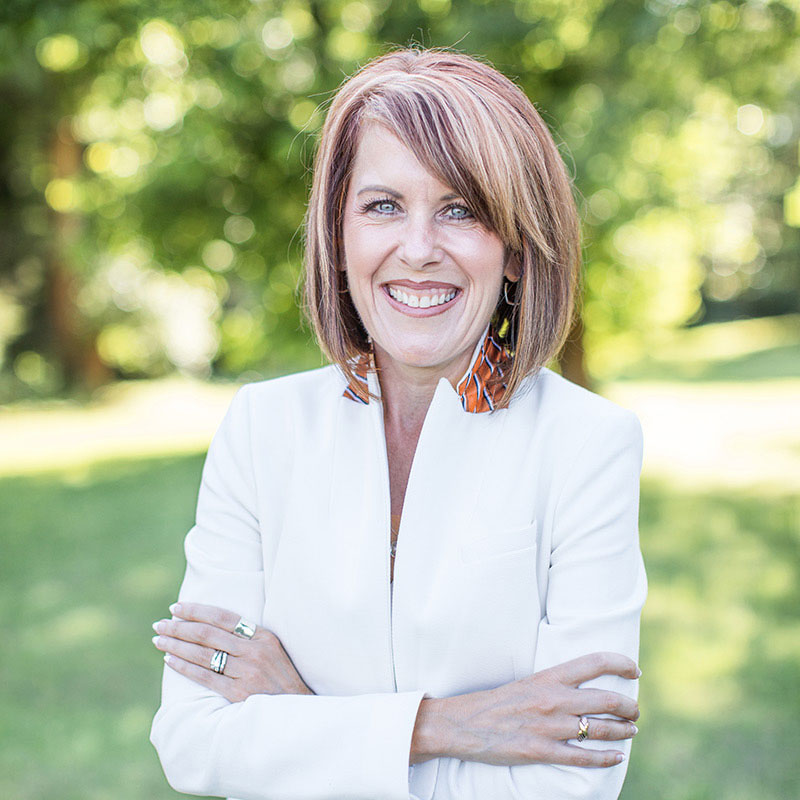
Q&A with Elizabeth Pollard, executive director of The Innovation Foundation at OSU and president of Cowboy Enterprises
The Hamm Institute for American Energy at Oklahoma State University launched in December 2021 with the goal of educating the next generation of energy leaders, advancing American energy and cementing Oklahoma’s legacy as a global energy leader. Now, nearly two years later, how would you assess the institute’s progress and momentum?
The Hamm Institute has made great strides in establishing relationships with industry, OSU faculty and other universities, setting the stage for applied research partnerships in the very near future. The Hamm Institute, leveraging The Innovation Foundation at OSU, has dedicated resources to create foundational infrastructure to ensure the success of upcoming research, development and partnering. I’m confident that those that work with the Hamm Institute will find collaboration that will lessen the administrative burden for faculty members, allowing them to more narrowly focus on their vitally important research.
What would you point to as key advancements for the Hamm Institute so far?
The American Energy Security Summit has been the highlight for the Hamm Institute. We gathered nearly 300 of the energy industry’s best and brightest for an invitation-only day of conversation and learning about one of the most important issues of our day — energy security. We welcomed national and global political leaders, energy and economic influencers and industry giants to speak, in addition to media outlets like CNBC and Bloomberg. It really put the institute on the map as a leader and champion of American energy.

Institutes like the Hamm Institute are major pillars in the We Are Land-Grant plan unveiled by President Kayse Shrum in 2022. Are institutes the future of transdisciplinary research, and why are they so important to OSU’s effort to become the nation’s preeminent land-grant institution?
Institutes truly exemplify the land-grant mission through their reciprocal relationship with industry. In conducting research that is closely tied with industry needs, institutes are able to provide real-time solutions and help to fill the workforce pipeline for critical and in-demand roles.
I look forward to maximizing OSU’s impact in applied research and commercialization of innovation. Our institutes and research community have positioned OSU as a technology leader in aerospace, agriculture, energy and One Health, to name a few. As a Carnegie R1 Research University with a longstanding tradition of discovery, The Innovation Foundation at OSU is primed to accelerate innovation and make a significant impact on prosperity in Oklahoma and beyond.
Why is the energy industry crucial to the Oklahoma economy, and what does Oklahoma’s leadership in this area mean in a national context?
The oil and gas industry has a total, annual economic impact of $64.9 billion in the state of Oklahoma, making up 27% of total statewide economic activity. This positions Oklahoma to be a national and international leader in energy exploration, production, distribution and innovation.
The recent conflicts in Ukraine are a prime example of why this is so important not only to our national security, but also to maintaining and improving quality of life both here and abroad.
What’s on the horizon for the Hamm Institute?
The American Energy Security Summit illuminated a few areas where the Hamm Institute can have the greatest impact: emissions management, advancing energy technologies for both new and traditional forms of energy production and distribution, and demandside innovations. All of these, of course, being supported with strong advocacy to help create policies that transcend political administrations.
Photos by: Phil Shockley and Gary Lawson
Story by: Mack Burke | STATE Magazine
